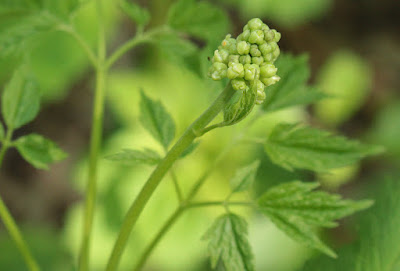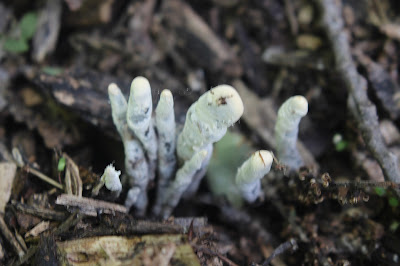This page shows plants most often found (so far) in the wooded areas of the
Assiniboine Forest. Some are generally considered wildflowers; others
are generally considered weeds. (Some plants listed on the
Wildflowers, Weeds,
Grasses & Such, and
Prairie Floor pages are also found in wooded areas).
Bold Italic
headings indicate species not listed on the Habitat Site Report.
Is It or Isn't It
Low Life of the Forest
Low and Delicate
Low-Lying Fruit Plants
Wild StrawberryDewberry
Baneberry, Red
Baneberry, White
Some Others
Indian PipeClick on Images to Enlarge
Is It or Isn't It
Poison Ivy
Rhus radicans var. rydbergii
Native Perennial, also known as Western Poison Ivy
Wild Sarsaparilla
Aralia nudicaulis
Native Perennial, also known as Wild Liquorice, False Sarsaparilla, Shot Bush, Small Spikenard, Rabbit Root
Composite photo showing very young Wild Sarsaparilla plants
emerging from the ground and developing leaves.
Young leaves
Clusters of typically three globe-shaped flower clusters are
found below plants on separate stems arising from the
root. The plant on the right has four.
Flower cluster
False Lily of the Valley
Maianthemum canadense
Native Perennial, also known as Star-Flowered Lily of the Valley, False Solomon's Seal, Canada May Lily, Canada Mayflower,
Lily of the Valley and Solomon's Seal can be very confusing, in part because some of their alternate names are the name of the other plant. See also the next heading.
This perennial features one to three leaves on a flowering
stem.
Close-Up
Low Life of the Forest
Large-Leaved Avens
Geum macrophyllum
Native Perennial
Fragrant Bedstraw
Galium triflorum
Native Perennial, also known as Sweet-Scented Bedstraw, Sweet Viburnum, Sheepberry
Northern Bedstraw
Ribes oxyacanthoides
Native Perennial, also known as Canadian Gooseberry
According to the Habitat Site Report, there are two species of
Gooseberry in the Assiniboine Forest, Bristly Wild (Canadian)
Gooseberry, and Low Gooseberry. According to another
source, those species are actually the same thing.
Gooseberry and Currant plants are quite similar, with both
belonging to the Ribes family.
Dewberry
Rubus pubescens
Native Perennial, also known as Dwarf Red Raspberry, Dwarf Red Blackberry
The Dewberry is widespread across the forest floor.
This photo shows several flowers and one berry, still
green.
Dewberry, Close-Up
Baneberry, Red
Actaea rubra
Native Perennial, also known as Chinaberry
I am assuming that the above photos are Red Baneberry
(Actaea rubra), because that is the only baneberry species
listed on the Habitat Site Report.
Baneberry, White
Actaea pachypoda
Native Perennial, also known as Doll's Eyes, White Cohosh
Some Others
Wild Licorice
Thalictrum dasycarpum
Native Perennial, also known as Tall Meadow-Rue
Spring growth. This plant has narrow
leaves.
Wider leaves on this mid-July photo.
Most Meadow-Rue plants in the forest are low to the
ground and do not develop vertical stalks or flower
heads in spring. Those which do are typically
about 30" tall.
Colour changing on this end-of-August
photo.
Variegated leaves on this October 1 photo.
Seed heads
Close-Up
Unidentified
The above two photos
appear to be the same
species. They
appear similar to
Northern Bedstraw, but
it isn't clear that
the leaves are in
whorls of four, which
is characteristic of
that species.
A low forest
plant. A young
High Bush
Cranberry?
Something
different?
The leaves of this
plant appear similar
to Wild Strawberry,
but are clusters of
five. Young
Virginia
Creeper?
The same as the above
photo, in autumn.


































































